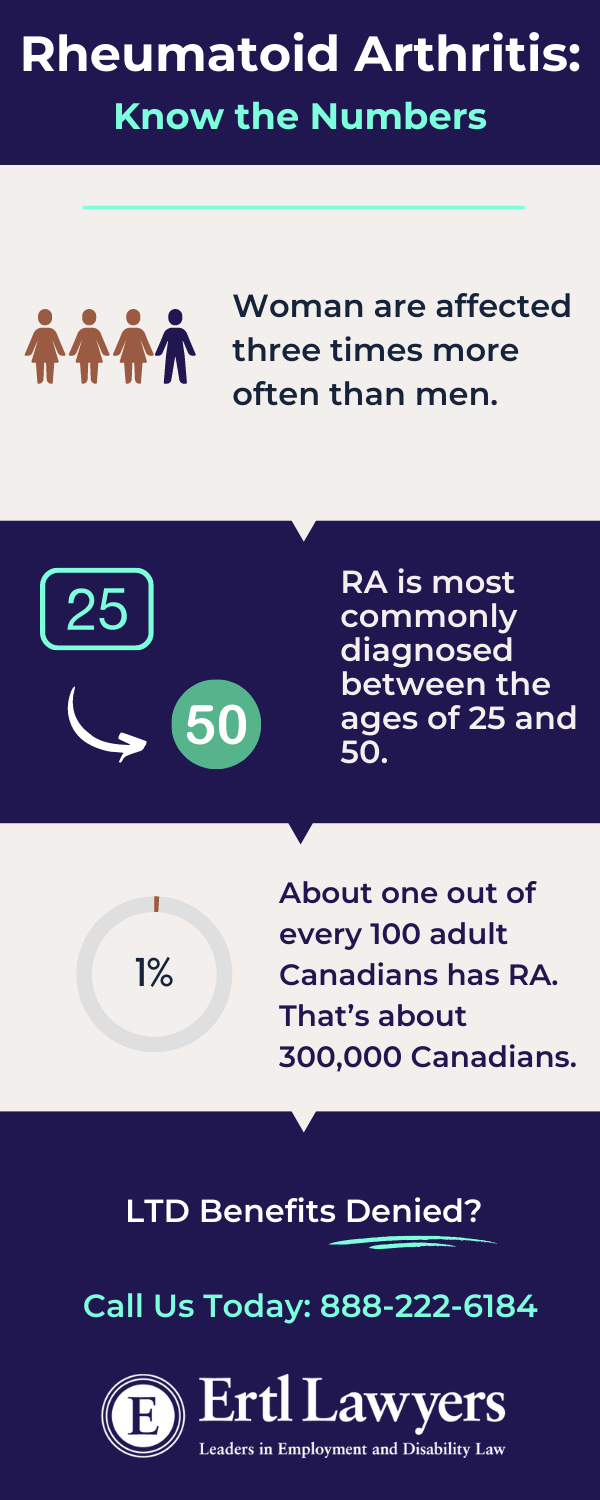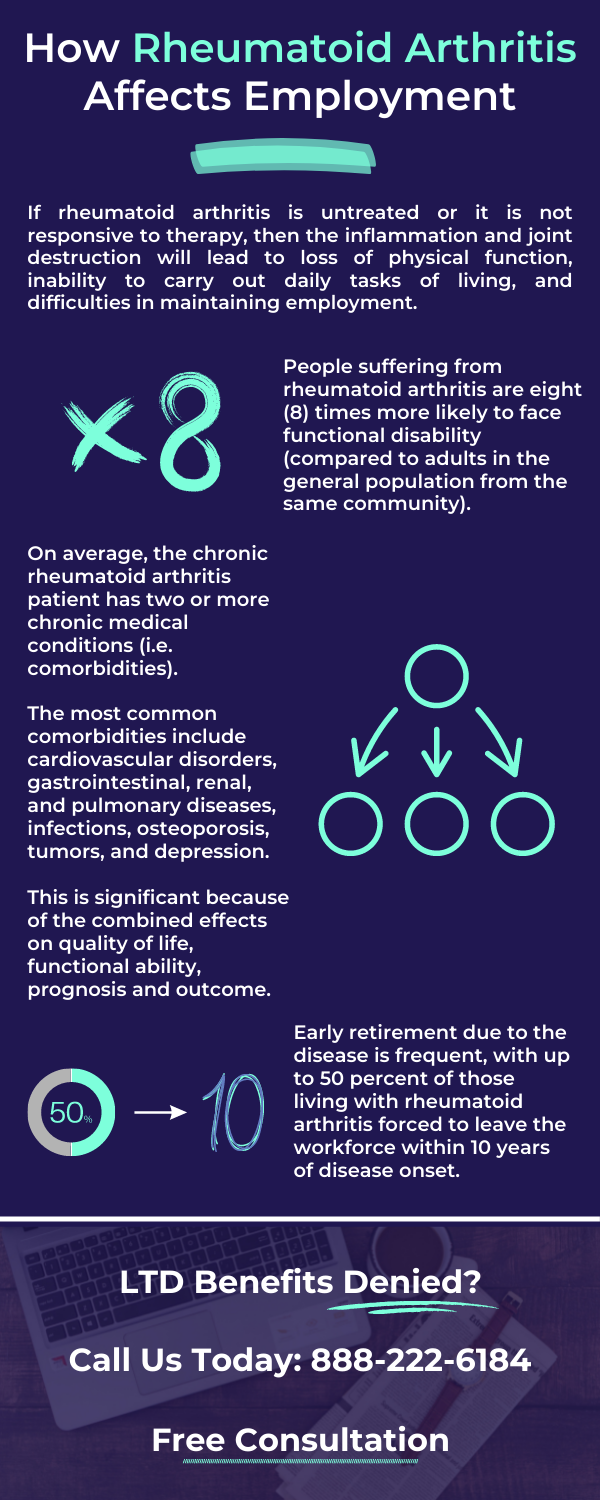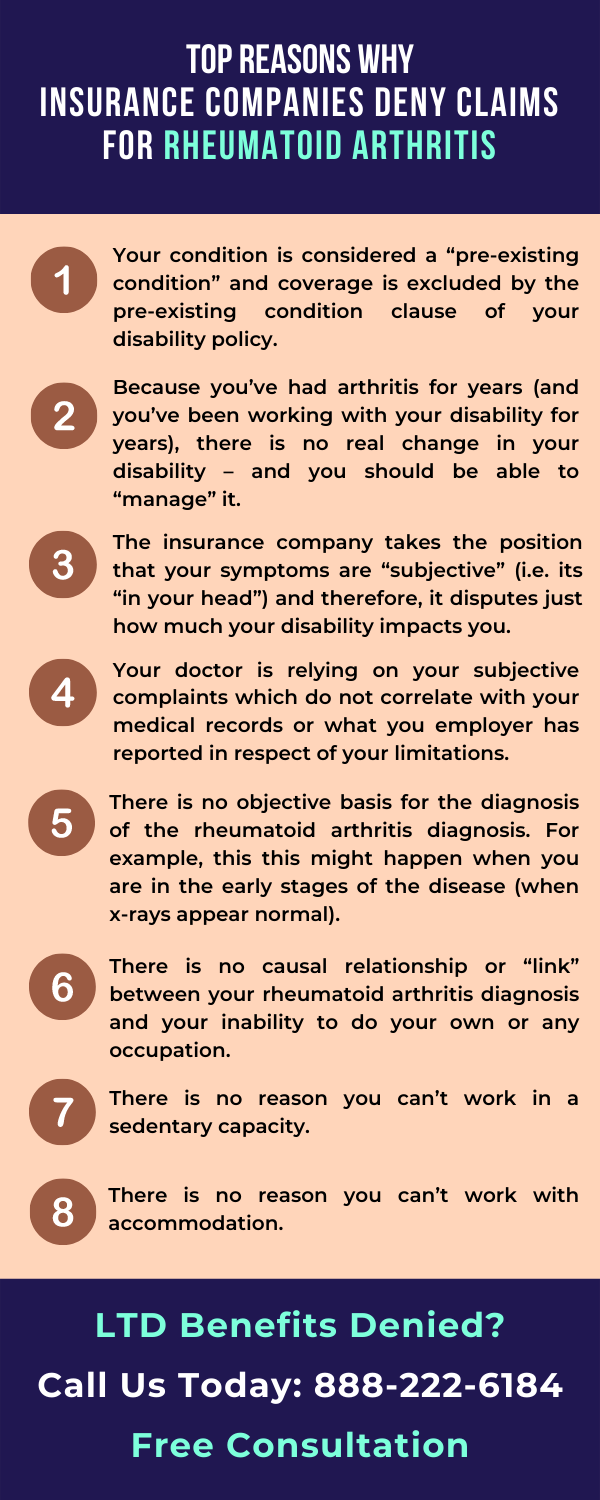Long-Term Disability Benefits for Rheumatoid Arthritis
Can I Get Long-Term Disability Benefits for Rheumatoid Arthritis in Canada?
Rheumatoid arthritis poses a significant health challenge for millions of people in Canada. For individuals suffering from severe rheumatoid arthritis, maintaining employment may feel impossible, leading to the question, “Am I eligible for long-term disability benefits for rheumatoid arthritis in Canada?”
This comprehensive guide will explore what rheumatoid arthritis is, the difficulties and restrictions it causes in the workplace, whether you can get disability benefits for rheumatoid arthritis, the steps you should consider if you wish to apply for disability benefits, the reasons why insurance companies frequently deny claims related to rheumatoid arthritis, and the importance of consulting with experts such as Ertl Lawyers to improve your experience throughout this process.
Rheumatoid Arthritis: Overview
a) What is Rheumatoid Arthritis?
Rheumatoid arthritis (aka “RA”) is considered an autoimmune disease, meaning the patient’s immune system mistakenly attacks healthy tissues, such as lupus or Crohn’s disease.
With rheumatoid arthritis, the immune system attacks the flexible synovial membrane of the joint, causing it to thicken. Consequently, the ligaments and tendons holding the joint together weaken and stretch. The joint loses its shape and alignment, resulting in deformity, dysfunction, and loss of use.
Rheumatoid arthritis usually affects the small joints first:
- Small joints of the hands and feet
- Wrists
- Ankles
As it progresses, the disease can affect larger joints:
- Elbows
- Knees
- Shoulders
- Jaw
- Neck
In many patients with rheumatoid arthritis (i.e. about 80%-90%), the cervical spine is involved. When that happens, the resulting instability can result in pain and other neurological symptoms, including headaches and tingling in the fingers.
While it mainly affects the body’s joints, rheumatoid arthritis is considered a systemic disease, meaning it can affect may parts of the body, including tissues and organs (such as eyes, skin, heart, the nervous system, lungs, blood, and musculoskeletal system.
There is no cure for rheumatoid arthritis. The goal of treatment (namely medication) is to reduce the inflammation and drive the disease into remission to slowing its progression.
See Canadian Rheumatology Association and Canada’s Arthritis Society
b) Most Common Symptoms of Rheumatoid Arthritis
Joint pain and Stiffness
Joint pain and stiffness commonly occur in the feet, knees, and hands. This can cause permanent joint destruction and deformity. Joint pain can be debilitating, and damage to joints can make it difficult to work or perform daily living activities.
Swollen and Tender Joints
Swollen joints and painful tenderness limit your ability to perform any work activity that requires you to use your feet, knees, and hands.
Fatigue
Debilitating fatigue that can severely limit work and day-to-day activities.
Note: Some rheumatoid arthritis patients may lose function in their joints as the disease progresses to a later stage
c) Criteria for a Diagnosis of Rheumatoid Arthritis
There is no “one test” to diagnose rheumatoid arthritis. Rather, a doctor (often a rheumatologist) will examine your complete history and perform a comprehensive examination, including blood tests and X-rays.
Frequently, the symptoms of rheumatoid arthritis can mimic the symptoms of other diseases, such as osteoarthritis, psoriatic arthritis, and Sjogren’s syndrome.
In 1987, the American College of Rheumatology (ACR) developed a list of seven criteria to help diagnose rheumatoid arthritis. According to this classification criteria, if a patient has four of the seven criteria (present for at least six weeks), then a person is said to have rheumatoid arthritis:
- Morning stiffness in and around joints for at least one hour
- Swelling and fluid around at least three joints at the same time
- At least one area in the hand, wrist, or finger joints that is swollen
- Symmetric arthritis, meaning arthritis occurring in the same joint on both sides of the body
- Manifestation of rheumatoid nodules (firm lumps in the skin, often occur in the pressure points of the body like the elbow)
- Abnormal levels of rheumatoid factor in the blood
- X-rays of the hands and wrists show signs of damage typical with rheumatoid arthritis.[1]
However, the 1987 criteria have come to be recognized as having poor performance in diagnosing early-stage rheumatoid arthritis.[2] So, in 2010, the ACR published new classification criteria to improve earlier diagnosis of rheumatoid arthritis in patients who may not meet the 1987 ACR criteria.[3]
However, due to the complexity and diversity of rheumatoid arthritis, medical science does not yet have a comprehensive diagnostic set of criteria readily available.
Indeed, this is why long-term disability insurers often deny claims for rheumatoid arthritis – because it can be difficult to diagnose accurately in its early stages.
Workplace Restrictions and Limitations Caused by Rheumatoid Arthritis
1. Physical Limitations
- Reduced Mobility: RA often affects the joints in the hands, knees, and feet, limiting an individual’s ability to walk, stand, or use tools effectively.
- Strength Issues: Muscle weakness and joint stiffness may make lifting, carrying, or moving heavy objects challenging.
- Dexterity Problems: Swollen or painful joints in the hands can make tasks requiring fine motor skills, such as typing, writing, or operating small equipment, more difficult.
- Fatigue: Chronic fatigue, a common symptom of RA, can reduce endurance and productivity during long workdays.
2. Cognitive and Psychological Impact
- Brain Fog: RA-related inflammation and fatigue can contribute to memory issues, difficulty concentrating, and slowed problem-solving skills.
- Mental Health Concerns: Chronic pain and the stress of managing a long-term condition may increase the risk of anxiety and depression, potentially affecting workplace interactions and focus.
3. Workplace Accessibility Challenges
- Difficulty with Prolonged Activities: Sitting, standing, or repetitive tasks for extended periods can exacerbate pain and stiffness.
- Access Issues: Workspaces that require climbing stairs, long walking distances, or inadequate seating may pose challenges for employees with RA.
- Environmental Triggers: Cold temperatures or poorly designed workstations can worsen symptoms by aggravating joint pain or stiffness.
4. Limitations in Job Types
- Physically Demanding Jobs: Occupations requiring heavy lifting, standing for extended periods, or repetitive joint movements are often unsuitable.
- High-Stress Jobs: Stress can worsen RA symptoms, making high-pressure roles more difficult to sustain.
Does Rheumatoid Arthritis Qualify As a Disability?
Rheumatoid Arthritis can significantly impact an individual’s ability to perform certain tasks or maintain a typical work routine. As a result, rheumatoid arthritis may qualify for long-term disability benefits, provided that your insurance policy does not specifically exclude it.
To be eligible for long-term disability benefits, certain criteria must be met to demonstrate the severity of your condition.
Important factors include:
- Medical Diagnosis: A formal diagnosis of fibromyalgia from a licensed healthcare professional is necessary.
- Functional Limitations: Your condition should hinder your ability to perform essential job functions.
- Treatment Efforts: You must show that you are actively pursuing recommended treatments, such as therapy or prescribed medication.
If your symptoms impede your ability to meet job requirements, you may qualify for disability benefits.
Short vs. Long-Term Disability Benefits for Rheumatoid Arthritis
Many employers in Canada offer both short-term and long-term disability insurance as part of their benefits package.
Short-Term Disability Benefits generally provide financial support for a limited duration, helping individuals who are undergoing treatment and recovery.
Long-Term Disability Benefits are designed for those who experience ongoing impairments that prevent them from working for an extended time. Claims related to fibromyalgia are usually filed under long-term disability if the symptoms last beyond the coverage period of short-term insurance. To obtain long-term disability benefits for fibromyalgia, it is essential to have comprehensive documentation and medical evidence.
Rheumatoid Arthritis and Workplace Discrimination
It is unlawful to discriminate against someone in the area of employment based on their physical disability: Ontario’s Human Rights Code and the Canadian Human Rights Act.
If you are suffering from rheumatoid arthritis, you might face discrimination in a variety of ways:
- You are terminated from your job because you have rheumatoid arthritis.
- You are denied accommodation because of your rheumatoid arthritis.
- After returning from a disability leave, your employer places you in a lower, part-time position at a lower rate of pay.
- Someone makes unwelcome remarks or jokes about your disability.
- Someone offends or humiliates you physically or verbally threatens or intimidates you because of your disability.
- Retaliating against you for filing a human rights complaint.
Ertl Lawyers are experts in Employment and Disability Law. If you have been discriminated against, we can help, including:
- Having your employer comply with their duty to accommodate you.
- Having your employer stop all forms of discriminatory conduct.
- Representing you in wrongful dismissal, constructive dismissal, and human rights matters.
- Ensuring that your employer complies with its statutory obligations, including its obligations under the Employment Standards Act.
- Negotiation severance packages (including continuation of benefits).
How to Apply for Long-Term Disability Benefits for Rheumatoid Arthritis in Canada
Navigating the process of applying for long-term disability (LTD) benefits can feel daunting, but knowing the necessary steps can make it easier. Here’s a concise guide to help you begin your application:
1. Review Your Insurance Policy
Start by carefully examining your employer-sponsored or personal disability insurance policy. These documents will outline the criteria for qualifying for LTD benefits, particularly concerning rheumatoid arthritis. Focus on:
- Definitions of “disability”
- Length of waiting periods before benefits kick in
- Necessary medical documentation
Tip: If anything is unclear, reach out to your HR department or insurance provider for clarification.
2. Collect Medication Documentation
Securing thorough medical records is a vital aspect of any disability claim. Ensure your healthcare providers cover:
- Diagnosis of rheumatoid arthritis
- Severity and impact of your symptoms
- Treatment plans (medications, therapy, etc.)
- Professional evaluations on your work capability
Consider requesting a detailed report from your psychiatrist or therapist, emphasizing how your condition affects your job performance.
3. Follow Your Treatment Plan
Insurance companies often seek evidence that applicants are actively managing their health issues. Attending therapy sessions and adhering to prescribed treatments demonstrates your commitment to recovery.
4. Initiate the Claim Process
Most long-term disability applications necessitate submitting forms to your insurer, typically filled out by you, your healthcare provider, and sometimes your employer. These forms will ask specific questions regarding your condition and how it affects your ability to work.
Tip: Provide comprehensive details when completing these forms, as vague responses can lead to delays or denials.
5. Prepare for Follow-Up Requests
If the insurer requests additional information or documentation, stay calm. Being proactive and responsive will help avoid unnecessary delays in processing your claim.
6. Consider Filing an Appeal if Needed
If your long-term disability claim is denied, remember you have the right to appeal the decision. Consulting with an experienced disability attorney can improve your chances of success during the appeals process.
What Other Benefits Might I Be Entitled to for Rheumatoid Arthritis?
Other than short-term and long-term disability benefits through a group or individual insurance plan, people suffering from rheumatoid arthritis might be entitled to one or more of the following benefits:
- Employment Insurance (EI) Sickness Benefits;
- Ontario Disability Support Plan (ODSP);
- Disability Tax Credit (DTC);
- Disability Creditor Insurance (under your mortgage or credit cards);
- Trillium (extended health benefits);
- Canada Pension Plan Disability (CPP-D); and
- Disability Pension (employer).
Additional Arthritis Resources
- Arthritis Society
- Canadian Rheumatology Association
- American College of Rheumatology
- Arthritis Foundation
How a Long-Term Disability Lawyer Can Help You
Navigating the disability claims process can be difficult, particularly when it comes to conditions like fibromyalgia. This is where the expertise of a long-term disability lawyer in Ontario can be incredibly beneficial.
Here’s how legal professionals can assist you:
Understanding Your Policy
Lawyers can help you make sense of the complicated language in your insurance documents, ensuring you understand the benefits you qualify for.
Building a Strong Appeal
If your initial claim is denied, an experienced long-term disability lawyer can gather necessary evidence, consult with healthcare providers, and file a compelling appeal on your behalf.
Starting Legal Action
Rather than relying solely on the insurance appeal process, a long-term disability lawyer can initiate legal proceedings if necessary.
Managing Insurance Companies
Many insurance companies prioritize their profits over fair payouts. A knowledgeable lawyer can effectively navigate their strategies and negotiate on your behalf.
Saving Time and Energy
Managing a disability claim while dealing with the symptoms of fibromyalgia can be overwhelming. Having legal representation allows you to focus on your health, knowing that your case is in capable hands.
Dealing With Your Employer
It is highly recommended that you hire a disability lawyer who is also an expert in employment law so you can effectively deal with employment issues that may arise from your disability, such as termination, wrongful dismissal, severance negotiations, accommodation, discrimination, human rights, etc.
Pursuing Disability Benefits with Confidence
Rheumatoid Arthritis is a significant medical condition that warrants attention and assistance. If you’re having difficulties at work, struggling to fulfill your job requirements, or looking for disability benefits related to fibromyalgia, there are resources available to support you.
If you’re uncertain about your next steps, consider contacting knowledgeable legal professionals such as Ertl Lawyers. They can help you navigate your claim and protect your rights. Although seeking help may feel overwhelming, it could be vital for improving your future.
Contact us today for a free case assessment.
Disclaimer: The content on this web site is provided for general information purposes only and does not constitute legal, medical, or other professional advice or an opinion of any kind. Users of this web site are advised to seek specific legal advice by contacting members of Ertl Lawyers (or their own legal counsel) regarding any specific legal issues. Ertl Lawyers does not warrant or guarantee the quality, accuracy or completeness of any information on this web site
Endnotes:
1. Arnett FC; Edworthy SM; Bloch DA; McShane DJ; Fries JF; Cooper NS, et al. The American Rheumatism Association 1987 revised criteria for the classification of rheumatoid arthritis. Arthritis and Rheumatism. 1988;31(3):315-324, Retrieved from https://onlinelibrary.wiley.com/doi/abs/10.1002/art.1780310302
2. Takeda A; Sugimoto H. Growing Need for Diagnostic Precision in Rheumatoid Arthritis: Proposal of MR imaging Criteria for Early Diagnosis. IntechOpen [Online], 2020, retrieved from: https://www.intechopen.com/books/connective-tissue-disease-current-state-of-the-art/growing-need-for-diagnostic-precision-in-rheumatoid-arthritis-proposal-of-mr-imaging-criteria-for-ea
3. Aletaha D; Alan T; Silman J; Funovits J; et al. Rheumatoid arthritis classification criteria: An American College of Rheumatology/European League Against Rheumatism collaborative initiative. Arthritis and Rheumatology [Online], 2010, Vol. 62, No. 9, Retrieved from https://onlinelibrary.wiley.com/doi/10.1002/art.27584
4. “Rheumatoid Arthritis,” Physiopedia (website), accessed September 1, 2020, https://www.physio-pedia.com/Rheumatoid_Arthritis
5. Klodzinski, L and Wislowska, M. Comorbidities in Rheumatic Arthritis. Rheumatologia [Online], 2018, Vol. 56(4). Retrieved from the National Centre for Biotechnology Information: https://www.ncbi.nlm.nih.gov/pmc/articles/PMC6142024/#:~:text=The%20most%20common%20comorbidities%20reported,8%5D%2C%20tumors%20and%20depression
6. “Rheumatoid Arthritis Sends Many Into Early Retirement.” ScienceDaily, 7 February 2008. Retrieved from: www.sciencedaily.com/releases/2008/02/080204102758.htm
Long-Term Disability Benefits Denied?
Ertl Lawyers provides expert representation in long-term disability matters.
The vast majority of disability matters are resolved through negotiation and mediation – and that’s because insurance companies know that we are passionate about our clients’ rights.
How we can help you:
• free disability policy analysis
• free case assessment
• applying for disability benefits
• appealing a denial or termination of your benefits
• disputing a denial through a legal claim
• handling all communications with your employer
• protecting your employment
• prosecuting human rights claims
Fair, Flexible Rates – Including Contingency Fees
(Don’t Pay Unless You Win)
Our Help Can Make All The Difference.
Related Blogs
What is Frustration of Contract in Ontario?
Simply put, in contract law, the frustration of a contract happens when one or more parties to the contract are unable to fulfil their contractual obligations due to unforeseeable circumstances outside of their control. As employment is based on an employment...
Your Guide to Overtime Pay in Ontario
Minus some exceptions to the rule, Ontario workers are entitled to overtime pay at 1.5 times their normal rate of pay (a.k.a 'time and a half') for every hour worked over 44 hours in a week. This applies to hourly and salaried employees and those who earn commissions....
What to Expect When Returning to Work After Disability Leave
If you've been away from work for a significant amount of time while you were on long-term disability (LTD) leave, you may understandably feel anxious and unsure of what to expect if you're returning to work. In this post, you'll learn about how a return-to-work plan...







